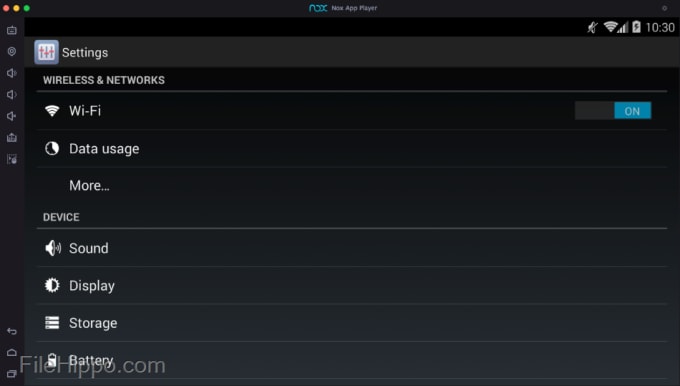In atmospheric chemistry, NO x is a generic term for the nitrogen oxides that are most relevant for air pollution, namely nitric oxide and nitrogen dioxide. These gases contribute to the formation of smog and acid rain, as well as affecting tropospheric ozone. NO x gases are usually produced from the reaction among nitrogen and oxygen during combustion of fuels, such as. With the use of Terminal, anyone can run multiple instances of the same application on a Mac. When you have multiple windows open in a web browser, the windows are all running under the same Process ID (PID). But, with multiple instances, each has its own unique PID. So why would you want to run multiple instances of the same app? There are several reasons a person may run clones of the same.
Installing software on a Mac is different from installing software on Windows. So for NoxPlayer. The first time you install and start Nox on your Mac, you may need to do the following to assure its proper running, which fixes the issue of stucking at 99%. Here is the tutorial as follows:
First Method
The first time you open NoxPlayer (or any downloaded application), you’ll see a warning. Agree to open the file and you won’t see the warning again. We suggest that you also tick the “Don’t warn me when opening application on this disk image” box.
Second Method
Third Method
3. You may also see the below warning when you start Mac version the first time. Here we assure you that Nox for Mac is a safe software you could trust. and please follow these steps:
- Open the System Preferences window
- Click the Apple icon at the top-left corner of your screen or click the System Preferences icon on your dock
- Click the Security & Privacy icon.
- Click the lock icon, enter your password, and set the “Allow apps downloaded from” option to “Anywhere.” Or click the “Open Anyway” button to bypass Gatekeeper in Mac.
Fourth Method

4. And if your mac verison is macOS Sierra, please click the “Allow” button in Security & Privacy to bypass Gatekeeper in Mac.
Fifth Method
- Shut down NoxPlayer and delete “Virtual Box” in Applications
- Visit /Applications/NoxAppPlayer.app/Contents/MacOS → Double click Nox.app →Enter password
- Click System Preferences → Security & Privacy → General → Click the “Allow” button
**Please note: NoxPlayer currently does not support Apple M1 Chip**
Context
Emissions of acidifying substances are actually a natural phenomenon (sulphur emissions from volcanoes, gas released by the activity of certain bacteria in the soil when organic matter is decomposing, etc.), although they have been amplified by certain human activities, primarily by combustion processes (heating, road transport, industry, etc.). This amplification is responsible for an increase in the acidification of soils and surface water, the degradation of vegetation and damage to certain materials used in the construction of buildings.

Box Osx
Sulphur dioxide SO2, nitrogen oxide NOx and ammonia NH3 are the three main gases, which contribute to the phenomenon of acidification. It should be noted however that NH3 is only potentially acidifying, depending on the environmental conditions (see the methodological sheet for more details).
Emitted amounts of acidifying substances per source
Almost 150 tonnes of acidifying substances (equivalent tonnes of acid) were emitted within the Brussels territory in 2012 and in 2013, of which more than 84% was NOx.
Road traffic alone accounted for 59% of the emissions of acidifying and potentially acidifying substances. In that same year, the sum of road transport and heating of buildings (residential and tertiary) represented 92% of the emissions.
Sectoral distribution of acidifying or potentially acidifying emissions in the Brussels-Capital Region, in 2012
Source: Brussels Environment, Dpt Planning air, energy and climate
2012 is used here since it corresponds to the most recent data from a validated version of the regional energy balance. Data from 2013 have actually been calculated using a provisional version of this balance.
As a comparison, the main emitters of acidifying substances or potentially acidifying substances in the Walloon Region in 2012 were agriculture, road transport, industry and the residential sector [Key Indicators of the Walloon Environment, 2014]. In the Flemish Region in 2013, the main emitters were agriculture (42%), transport (24%), industry (17%) and energy production (9%) [MIRA, March 2015].
Road transport and building heating are therefore proportionally less significant sources for the other Regions, compared with agriculture and industry. These differences are attributed to the mainly urban character of the Brussels-Capital Region.
Evolution of the emitted amounts
Between 1990 and 2013, the emissions of acidifying and potentially acidifying substances dropped by 57 % (148 tonnes of Aeq. in 2013 versus 344 tonnes of Aeq. in 1990).

Hence, SOx experienced a proportionally stronger decrease than NOx.
Evolution of the acidifying or potentially acidifying emissions in the Brussels-Capital Region between 1990 and 2013
Source: Brussels Environment, Dpt Planning air, energy and climate
(* Data for 2013 have been calculated from a provisional version of the regional energy balance.)
The factors explaining this evolution vary depending on the substances.

The reduction in emissions of SOx is explained by:
- a reduction in the content of sulphur in vehicle fuels (in particular since 1996) and in heating oil (limited to 0.2% by weight since 1989),
- the growing proportion of natural gas in the total consumption of fuels, at the expense of petroleum products,
- the decline in production at the Marly coking plant in 1990, followed by its closure in 1993,
- and the installation of a fume cleaning system at the waste incinerator – Brussels Energy (mid 1999).
The reduction in emissions of NOx is related among other reasons to:
- the decline in production at the Marly coking plant in 1990, followed by its closure in 1993,
- the installation of a fume cleaning system ('DeNOx') at the waste incinerator at Neder-Over-Heembeek (2006),
- the enhancements of engine performances thanks to the introduction of certain European directives regarding the emission of pollutants from different vehicle categories ('EURO standards'),
- the standardisation of catalytic converters on new vehicles as of 1993 (which subject the exhaust gases to a post-treatment upon leaving the engine, resulting in reduced NOx emissions, particularly for petrol cars). The importance of the catalytic converter with regard to the reduction of NOx emissions in the Brussels Region should be put into perspective, however, as the effect of a catalytic converter only becomes apparent after travelling several kilometres (when the engine is cold, during ignition and acceleration/deceleration, the catalytic converter is completely or partially ineffective). Hence, this factor only applies to longer distances.
Finally, since emissions of NH3 are negligible, it is difficult to interpret the observed trends.
European standards
European directive 2001/81/EC (referred to as the 'NEC' directive) sets national emissions ceilings for acidifying air pollutants. The emissions ceilings for NOx and SOx are respectively 176 and 99 kilotonnes for Belgium.
The Inter-ministerial Conference for the Environment (ICE) of 16 June 2000 split these national ceilings into three regional ceilings for stationary sources, in other words excluding transport. The ceiling was kept at the national level for mobile sources.
Following this effort-sharing, the Brussels-Capital Region needed to meet the following ceilings from 2010 onwards: annual emissions of 1.4 kilotonnes of SO2 and 3 kilotonnes of NOx (for stationary sources), in other words 0.04 et 0.07 kilotonnes of acid equivalent respectively. The Region achieved its objectives.
Nox Os X 99

Sox Nox Emissions Limits
The BCR was not given a specific ceiling for NH3 as this substance is relatively less significant in the emissions.